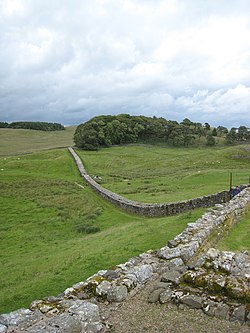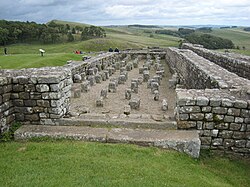Housesteads Fort
| Housesteads Latin: Vercovicium | |
| Northumberland | |
|---|---|

| |
| Type: | Roman fort |
| Location | |
| Grid reference: | NY789687 |
| Location: | 55°-0’47"N, 2°19’52"W |
| History | |
| Built c. AD 124 | |
| Information | |
| Owned by: | National Trust |
| Website: | Housesteads Roman Fort |
Housesteads Fort, known to the Romans as Vercovicium stands on Hadrian's Wall, the Romans' frontier, in Northumberland. It was built to defend the wall and thus the frontier of Britannia, as the wall itself was built, and it was garrisoned strongly with auxiliaries.[1]
The fort's impressive ruins are to be found at Housesteads in the parish of Bardon Mill, south of Broomlee Lough.
History
In the 2nd century AD, the garrison consisted of an unknown double-sized auxiliary infantry cohort and a detachment of legionaries from Legio II Augusta. In the 3rd century, it comprised Cohors I Tungrorum (an auxiliary cohort of the Tungrian tribe), augmented by the numerus Hnaudifridi and the cuneus Frisiorum (the latter both Germanic names). The Tungrians were still there in the 4th century, according to the Notitia Dignitatum. By AD 409 the Romans had withdrawn.[2]
The fort was built in stone around AD 124, soon after the construction of Hadrian's Wall began in AD 122. Vercovicium was built overlying the original Broad Wall foundation and Turret 36B. The fort was repaired and rebuilt several times, its northern defences being particularly prone to collapse. A substantial civil settlement (vicus) existed to the south, outside the fort, and some of the stone foundations can still be seen, including "Murder House", where two skeletons were found beneath an apparently newly laid floor when excavated.




The fort is unusual for Britain in that it has no running water supply and is dependent upon rainwater collection (for which purpose there is a series of large stone-lined tanks around the periphery of the defences). It also has one of the best-preserved stone latrines in Roman Britain.
The site is now owned by the National Trust and is currently in the care of English Heritage. Finds from Vercovicium can be seen in the site museum, in the museum at Chesters, and in the Museum of Antiquities in Newcastle upon Tyne.
Housesteads farm
Housesteads is a former farm whose lands include the ruins of Vercovicium. In 1604 Hugh Nixon, "Stealer of cattle and receiver of stolen goods", became the tenant of Housesteads farm. From 1663, Housesteads was the home of the Armstrongs, a notorious family of Border Reivers. Nicholas Armstrong bought the farm in 1692, only to have to sell it again in 1694 to Thomas Gibson of Hexham for the sum of £485. They remained as tenants. The Armstrongs were a notorious band of horse thieves and cattle rustlers and they used the old Roman fort as a corral for their ill-gotten gains. They traded as far afield as Aberdeen and the southern counties. At one time every male member of the family was said to have been a 'broken man', formally outlawed by English or Scottish authorities. Nicholas was hanged in 1704, and his brothers fled to America.
The Armstrongs lived in a typical 16th century defensive bastle house of two storeys: the ground floor for livestock and the upper level for living quarters. Its ruins remain built up against the south gate of the Roman fort and clearly show its defensive nature, with external stone steps and narrow loop windows. A corn drying kiln was inserted into the gate's guard chamber in the 17th century.
In 1698, the farm had been sold to Thomas Gibson who turned the land around the fort to agriculture and thus ploughed up numerous Roman artefacts. The 17th-century bastle was replaced by a farmhouse located over the Roman hospital, which was sketched by Stukely in 1725. Throughout the 18th Century Housesteads was farmed by a single tenant farming family. Since Hodgson recorded the presence of William Magnay as the tenant during that period this fixes the tenure. In particular, the well (thought to be Roman) was documented as having actually been built by William, and used by the family as a bath.
Interest in the fort increased in the 19th century, particularly after the farm was purchased by the historian, John Clayton, in 1838, to add to his collection of Roman Wall farms. The Roman site was cleared of later buildings by Clayton, and the present farmhouse built about 1860. John Maurice Clayton attempted to auction the fort in 1929. It did not reach its reserve and was donated to the National Trust in 1930.
The farm was later owned by the Trevelyans who gave the land for the site museum.
Outside links
| ("Wikimedia Commons" has material about Housesteads Fort) |
- VERCOVICIUM FORT On the line of Hadrian's Wall as it exists today
- Housesteads Fort – National Trust
- Housesteads Roman For Hadrian's Wallt – English Heritage
- Housesteads Roman Fort – The Grandest Station – Historic England
- Tour of Housesteads Roman Fort
References
- Bibliography
- Birley, Eric (1952). Housesteads Roman Fort. London: English Heritage.
- Dodds, Glen Lyndon, (2002) Historic Sites of Northumberland & Newcastle upon Tyne pp 96–103
- Housesteads Bastle House on CastleUK.net
- Hickey, Julia. "Carlisle and the Border Reivers". TimeTravel-Britain.com. http://www.timetravel-britain.com/06/Oct/reivers.shtml. Retrieved 8 February 2006.
- Gibson papers, Northumberland Record Office (NRO)
- J. C. Crow, Housesteads Roman Fort and its Environs, Univ. of Newcastle 1994
- J. Crow, 'Housesteads', Bath Press 1995
- John Hodgson: History of Northumberland vol III part II page 288
- Crow, J. Housesteads, London: Batsford (1995) (second edition, Stroud: Tempus 2004)
- Rivet, A.L.F. The Place-Names of Roman Britain, London: Batsford (1979)
| Forts on Hadrian's Wall | ||
|---|---|---|
| Wall forts (west to east) |
Maia • Coggabata • Aballava • Uxelodunum • Camboglanna • Birdoswald (Banna) • Magnae • Aesica • Housesteads (Vercovicium) • Carrawburgh (Procolita) • Cilurnum • Onnum • Vindobala • Condercum • Pons Aelius • Segedunum | |
| Stanegate forts |
Luguualium • Brampton Old Church • Castle Hill Boothby • Nether Denton • Throp • Magnis • Haltwhistle Burn • Vindolanda • Newbrough • Corstopitum | |
| Outpost Forts |
Habitancum • Fanum Cocidi • Castra Exploratorum • Blatobulgium | |
| Cumberland coast forts (north to south) |
Bibra • Alauna • Burrow Walls • Gabrosentum | |